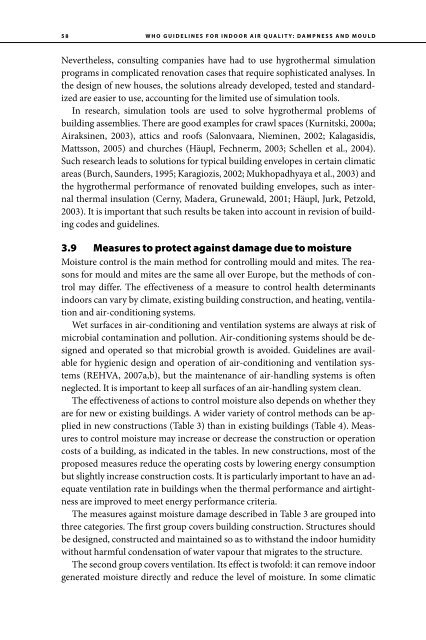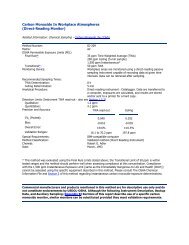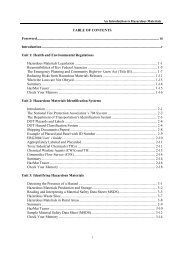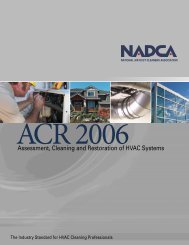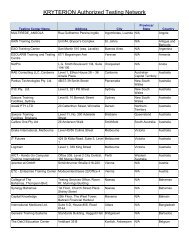Dampness and Mould - WHO guidelines for indoor air quality - PRWeb
Dampness and Mould - WHO guidelines for indoor air quality - PRWeb
Dampness and Mould - WHO guidelines for indoor air quality - PRWeb
You also want an ePaper? Increase the reach of your titles
YUMPU automatically turns print PDFs into web optimized ePapers that Google loves.
58<br />
<strong>WHO</strong> GUIDELINES FOR INDOOR AIR QUALITY: DAMPNESS AND MOULD<br />
Nevertheless, consulting companies have had to use hygrothermal simulation<br />
programs in complicated renovation cases that require sophisticated analyses. In<br />
the design of new houses, the solutions already developed, tested <strong>and</strong> st<strong>and</strong>ardized<br />
are easier to use, accounting <strong>for</strong> the limited use of simulation tools.<br />
In research, simulation tools are used to solve hygrothermal problems of<br />
building assemblies. There are good examples <strong>for</strong> crawl spaces (Kurnitski, 2000a;<br />
Airaksinen, 2003), attics <strong>and</strong> roofs (Salonvaara, Nieminen, 2002; Kalagasidis,<br />
Mattsson, 2005) <strong>and</strong> churches (Häupl, Fechnerm, 2003; Schellen et al., 2004).<br />
Such research leads to solutions <strong>for</strong> typical building envelopes in certain climatic<br />
areas (Burch, Saunders, 1995; Karagiozis, 2002; Mukhopadhyaya et al., 2003) <strong>and</strong><br />
the hygrothermal per<strong>for</strong>mance of renovated building envelopes, such as internal<br />
thermal insulation (Cerny, Madera, Grunewald, 2001; Häupl, Jurk, Petzold,<br />
2003). It is important that such results be taken into account in revision of building<br />
codes <strong>and</strong> <strong>guidelines</strong>.<br />
3.9 Measures to protect against damage due to moisture<br />
Moisture control is the main method <strong>for</strong> controlling mould <strong>and</strong> mites. The reasons<br />
<strong>for</strong> mould <strong>and</strong> mites are the same all over Europe, but the methods of control<br />
may differ. The effectiveness of a measure to control health determinants<br />
<strong>indoor</strong>s can vary by climate, existing building construction, <strong>and</strong> heating, ventilation<br />
<strong>and</strong> <strong>air</strong>-conditioning systems.<br />
Wet surfaces in <strong>air</strong>-conditioning <strong>and</strong> ventilation systems are always at risk of<br />
microbial contamination <strong>and</strong> pollution. Air-conditioning systems should be designed<br />
<strong>and</strong> operated so that microbial growth is avoided. Guidelines are available<br />
<strong>for</strong> hygienic design <strong>and</strong> operation of <strong>air</strong>-conditioning <strong>and</strong> ventilation systems<br />
(REHVA, 2007a,b), but the maintenance of <strong>air</strong>-h<strong>and</strong>ling systems is often<br />
neglected. It is important to keep all surfaces of an <strong>air</strong>-h<strong>and</strong>ling system clean.<br />
The effectiveness of actions to control moisture also depends on whether they<br />
are <strong>for</strong> new or existing buildings. A wider variety of control methods can be applied<br />
in new constructions (Table 3) than in existing buildings (Table 4). Measures<br />
to control moisture may increase or decrease the construction or operation<br />
costs of a building, as indicated in the tables. In new constructions, most of the<br />
proposed measures reduce the operating costs by lowering energy consumption<br />
but slightly increase construction costs. It is particularly important to have an adequate<br />
ventilation rate in buildings when the thermal per<strong>for</strong>mance <strong>and</strong> <strong>air</strong>tightness<br />
are improved to meet energy per<strong>for</strong>mance criteria.<br />
The measures against moisture damage described in Table 3 are grouped into<br />
three categories. The first group covers building construction. Structures should<br />
be designed, constructed <strong>and</strong> maintained so as to withst<strong>and</strong> the <strong>indoor</strong> humidity<br />
without harmful condensation of water vapour that migrates to the structure.<br />
The second group covers ventilation. Its effect is twofold: it can remove <strong>indoor</strong><br />
generated moisture directly <strong>and</strong> reduce the level of moisture. In some climatic


